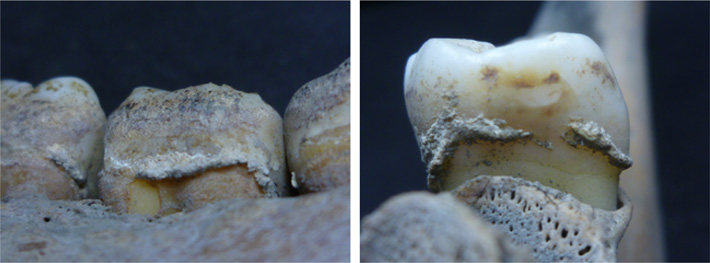Dental Tartar Yields Food Data from Japan’s Edo Period
Rikai Sawafuji of the University of the Ryukyus, Shintaroh Ueda of the University of Tokyo, and their colleagues analyzed samples of tartar from the teeth of 13 people who were buried in what is now eastern Tokyo in the latter half of the Edo Period, from A.D. 1603 to 1867. DNA from the rice was identified in the tartar of eight of the individuals. The DNA of other foods, including daikon radish, the minty herb “shiso” perilla, green onion, Japanese chestnut, carrot, and the pumpkin was also identified.

However, the scientists from the University of the Ryukyus, the University of Tokyo, and elsewhere identified even the families and genera of plants eaten at the time by surveying calculus on the teeth of human remains.
The findings, expected to shed light on the dietary and other habits of people of the time, were published in the academic journal Plos One. The team of scientists sampled the DNA from teeth on the bones of 13 people unearthed in Tokyo’s Koto Ward that date to the latter half of the Edo Period.
The researchers studied what plant the samples are from, as recent research has revealed tartar contains the DNA of what was consumed by the individuals. According to the team’s findings, rice-derived DNA was detected from calculus specimens of eight people, while DNA highly likely connected to such plants as the daikon radish, “shiso” perilla, Welsh onion, Japanese chestnut, carrot and pumpkin from nine genera in seven families were also discovered.
Those plants are, according to the scientists, described as foods in records from the period. Meanwhile, DNA from the tobacco genus was identified as well, reinforcing the theory that smoking had already become a popular practice by that time.
A Dipterocarpaceae-linked DNA sample, which is typically found in the tropics, indicates that the resin of the plant was used as an ingredient for tooth powder in the Edo Period, the scientists said.
Team members included Rikai Sawafuji from the University of the Ryukyus, a research fellow affiliated with the Japan Society for the Promotion of Science who now belongs to the Graduate University for Advanced Studies; and Shintaro Ueda, a professor emeritus of bioscience at the University of Tokyo.
Sawafuji expressed high expectations for the possibility of the DNA analysis allowing researchers in the future to determine even people’s personal favorites based on the remnants left behind on their teeth.
“The technique will make it possible to survey what each individual ate,” said Sawafuji.
Another anticipated benefit of the method is that how plants were used, including the staple foods of each era, which can be determined, because “plants detected from the teeth of many people’s remains were likely widely consumed.”
Tartar as Research Specimen
In the past, calculus formations remaining in human skulls were often simply removed, since their presence made it difficult to examine the shapes of teeth and other factors.
But DNA, starch particles, proteins, and other substances contained in tartar can currently be surveyed in detail, adding to calculus’ significance for research purposes.
Among other ways to take advantage of tartar, the DNA analysis was introduced 10 or so years ago, although more than 99 percent of DNA detected from the object come from bacilli and the method was first adopted to research changing bacterial floras in the oral cavity.
In the early stage of the development, a study was carried out in 2014 to collect DNA from pork and wheat ingested by Germans in the medieval period.
In 2017, the results of the analysis of calculus from Neanderthal men dating to 50,000 years ago were released, showing they ate different foodstuffs in different regions because DNA from mutton and other kinds of meat, as well as moss and mushrooms, were found.
As the poplar-derived DNA was also discovered, speculation swirled that the plant, currently used for making aspirin, “could be used to ease the pain.”
Hiroki Ota, a bioscience professor at the University of Tokyo, noted, however, that the DNA-based method should be combined with various other techniques for improved research.
“Tartar DNA no doubt reflects what the person ate, so use of the substance will spread further,” said Ota. “But calculus could be formed differently in differing dietary cultures. So the research accuracy needs to be improved by conducting a variety of methods using coprolites (fossilized feces) and other objects to uncover all details.”





